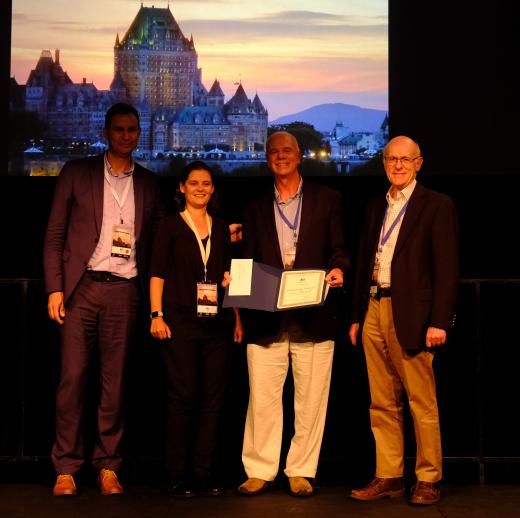James Duncan Wins MICCAI Enduring Impact Award

Having made a career of coming up with better ways to analyze biomedical images, James Duncan, the Ebenezer K. Hunt Professor of Biomedical Engineering, Electrical Engineering & Radiology and Biomedical Imaging, received the Enduring Impact Award from Medical Image Computing and Computer Assisted Intervention Society (MICCAI).
 The award was presented earlier this month at the annual MICCAI meeting in Quebec, with more than 1,300 in attendance. The Enduring Impact Award is given annually to a senior researcher whose work has made lasting contributions to the field of medical image computing and computer-assisted interventions. Winners are selected through a combination of originality of research, successful applications, strong clinical applicability, publications, service to the community, and delivery of high-value educational material.
The award was presented earlier this month at the annual MICCAI meeting in Quebec, with more than 1,300 in attendance. The Enduring Impact Award is given annually to a senior researcher whose work has made lasting contributions to the field of medical image computing and computer-assisted interventions. Winners are selected through a combination of originality of research, successful applications, strong clinical applicability, publications, service to the community, and delivery of high-value educational material.
After receiving a degree in electrical engineering at Lafayette, Duncan went to work in aerospace while getting a master’s degree in engineering from UCLA and a Ph.D. in image processing from the University of Southern California. He came to Yale in 1983, where he is currently jointly appointed in Radiology & Biomedical Imaging, Biomedical Engineering and Electrical Engineering.
“When I first started in this field, it was evident that many of the ideas and the technology embedded in the image processing & analysis algorithms that I was using in grad school and in my aerospace work were applicable to biomedical image data sets,“ said Duncan who is one of the founding co-editors of the journal Medical Image Analysis. “This is what got me started in biomedical image analysis research, and with integrated strengths in both engineering and medicine, it was clear that Yale was a wonderful place to pursue a career in this field.”
Duncan’s work has led to numerous breakthroughs in the field and has resulted in over 245 peer-reviewed publications, more than $43 million in federal, peer reviewed funding as principal investigator (National Institutes of Health and the National Science Foundation) and six U.S. patent filings. His research has produced tools for tracking types of motion and soft tissue deformation in the heart, and strategies to locate gray matter structures in the brain and anatomical structure near the prostate gland and the liver.
“It’s all about taking image information and applying model-based and/or data driven mathematical decision-making strategies to develop algorithms, based on engineering principles and machine learning, to understand the disease and to help treat the disease,” he said.
The annual MICCAI meeting is one of the key forums for the field of medical image computing, where researchers develop algorithms based on ideas from engineering, statistics, computer science, applied mathematics and machine learning to analyze medical images. There, Duncan and his graduate students/postdocs (Allen Lu, Nripesh Parajuli, John Treilhard and Nicha Dvornek) presented four papers.
One of these papers involves the use of the multiple types of magnetic resonance image data to estimate what types of tissue are in a patient with liver cancer. “We’ve developed algorithms to classify the tissue type and map it out in the body,” he said. An interventional radiologist then uses it as a guide to target tumors with nanoparticle-based drug deliveries. They can also use the image data to predict who’s going to respond to the therapy over certain periods of time. A second paper similarly looks as using a machine learning strategy to guide targeted therapy of myocardial injury using information from ultrasound image sequences, to improve cardiac function in patients who have suffered heart attacks.
In addition, his research team is looking at brain networks to get a better sense of who will respond best to intense cognitive therapy for children with autism, one aspect of which was presented at a Workshop on Machine Learning in Medical Imaging held as part of the larger MICCAI meeting.

